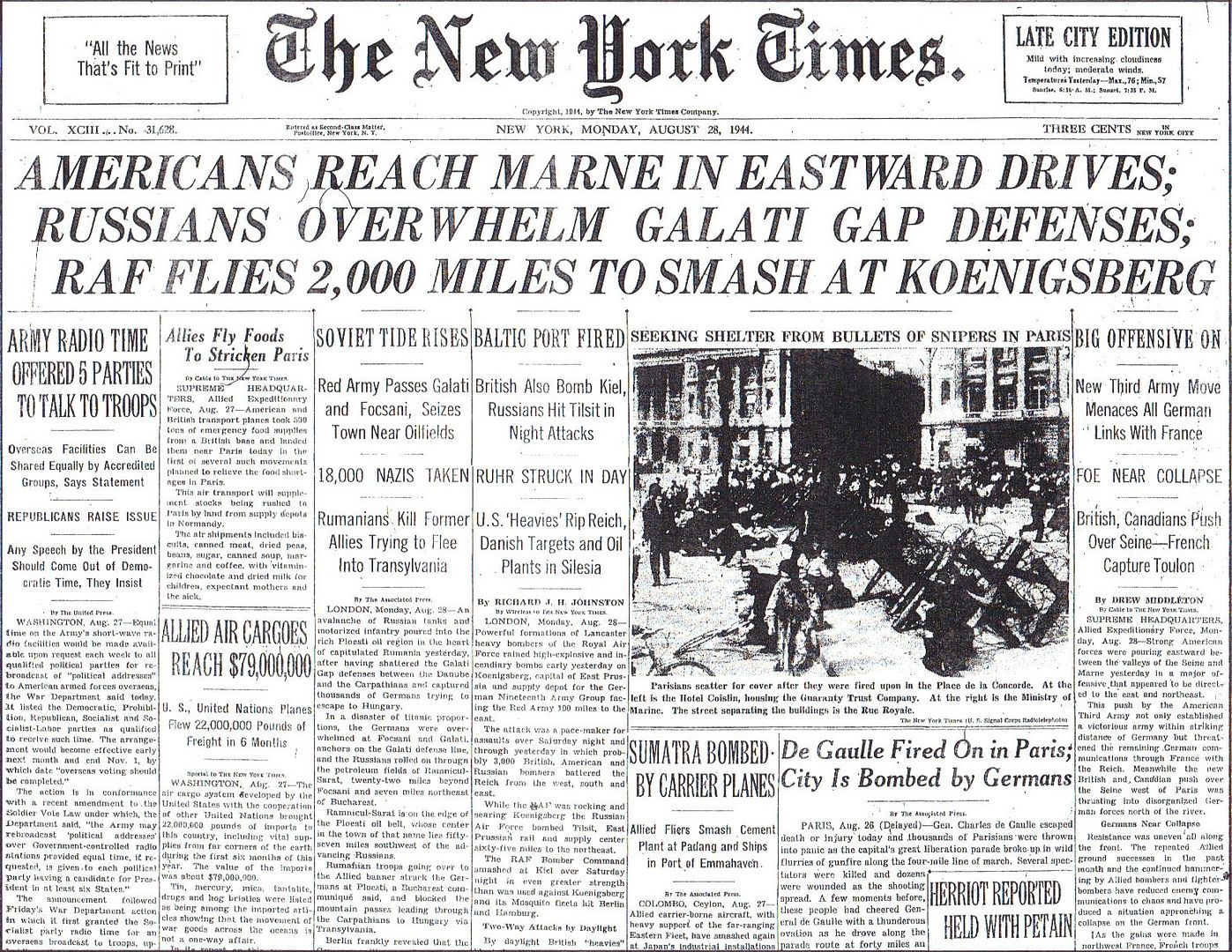
Posted on 08/28/2014 4:20:02 AM PDT by Homer_J_Simpson

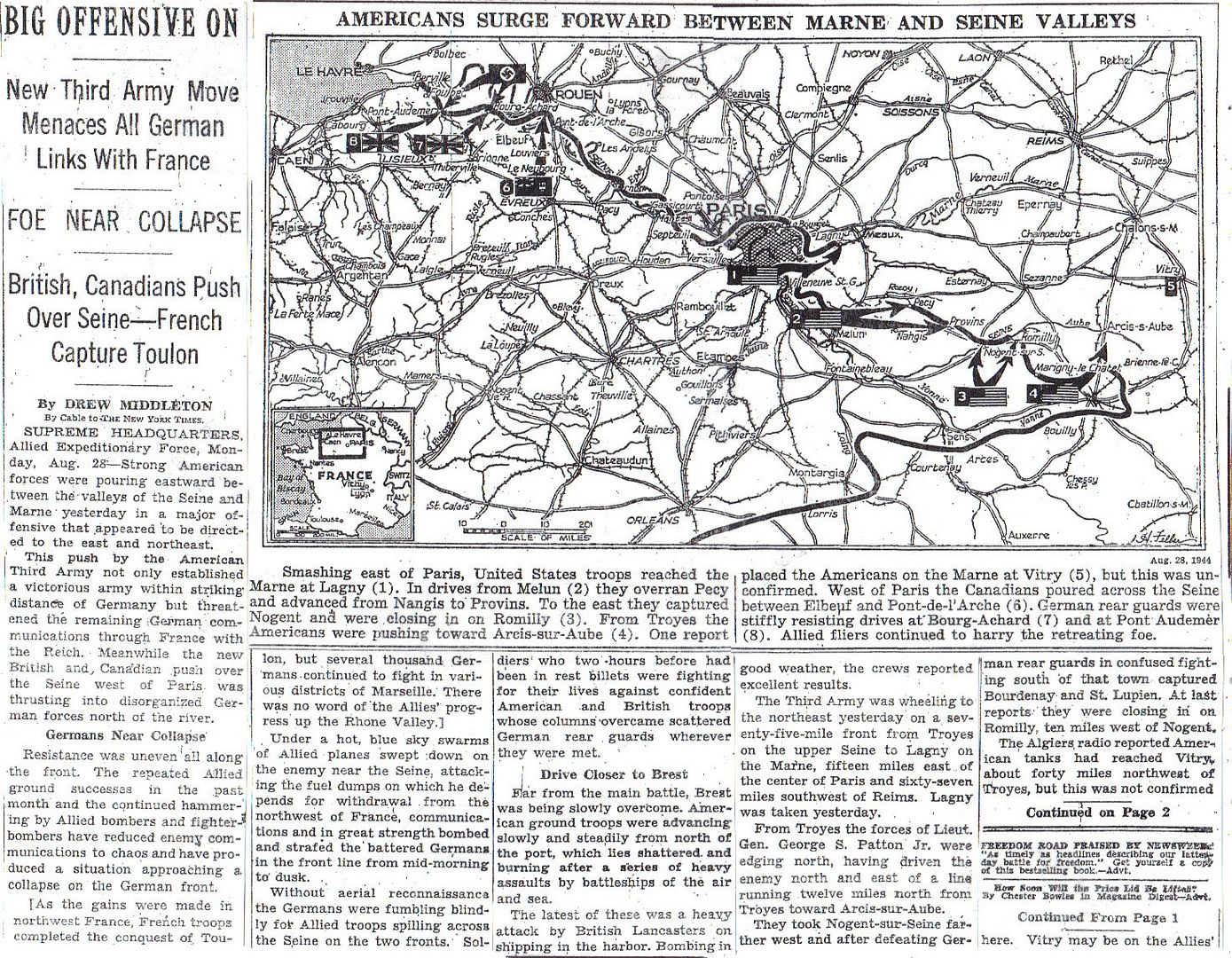
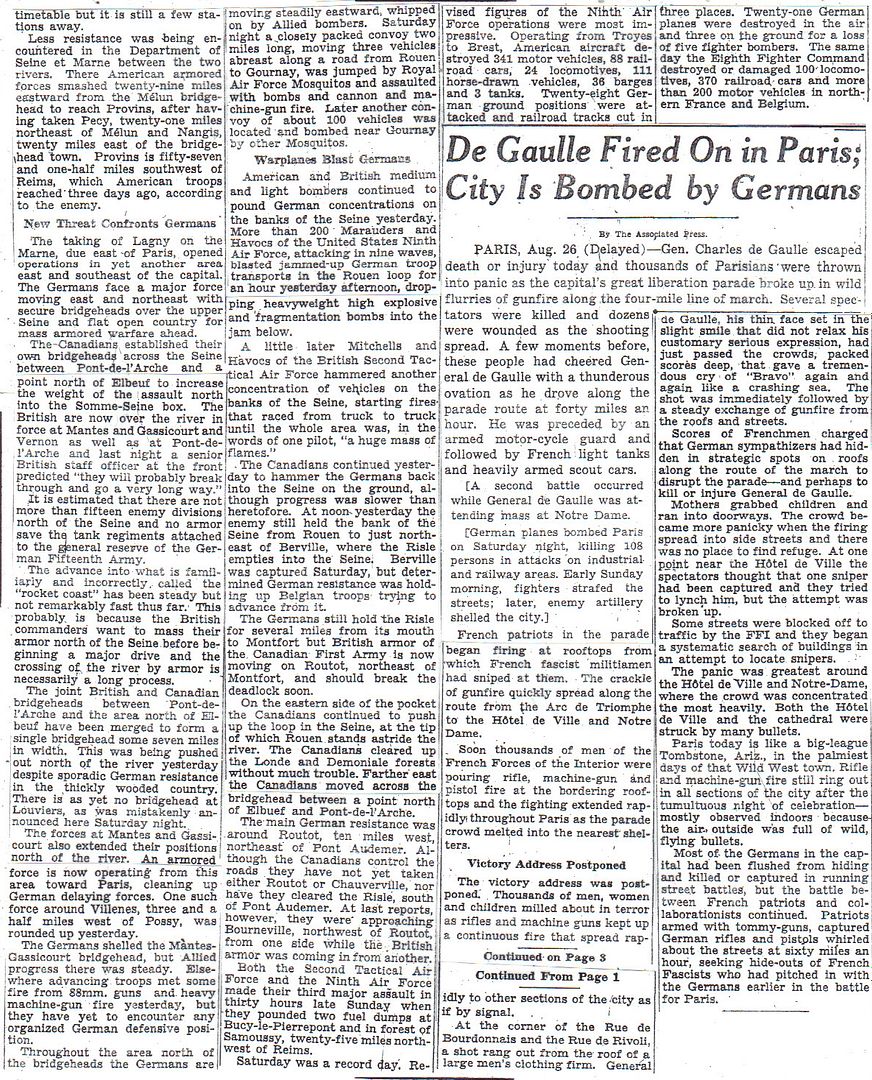
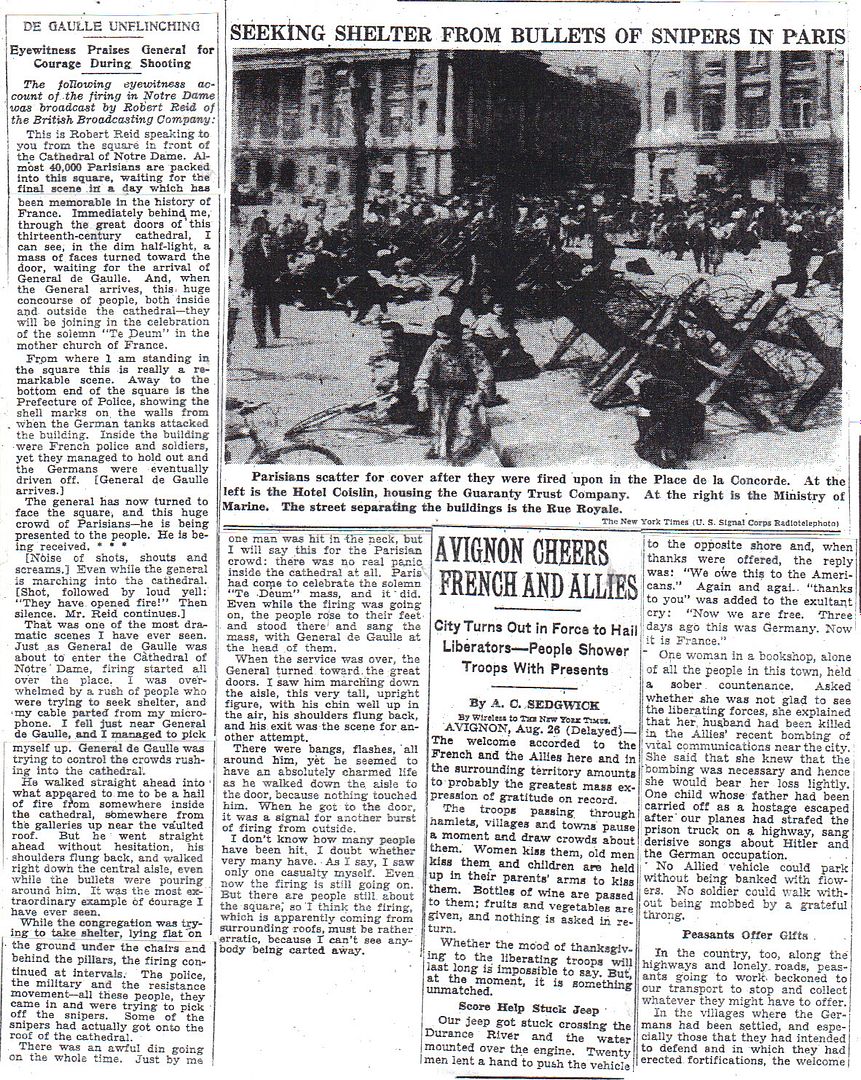

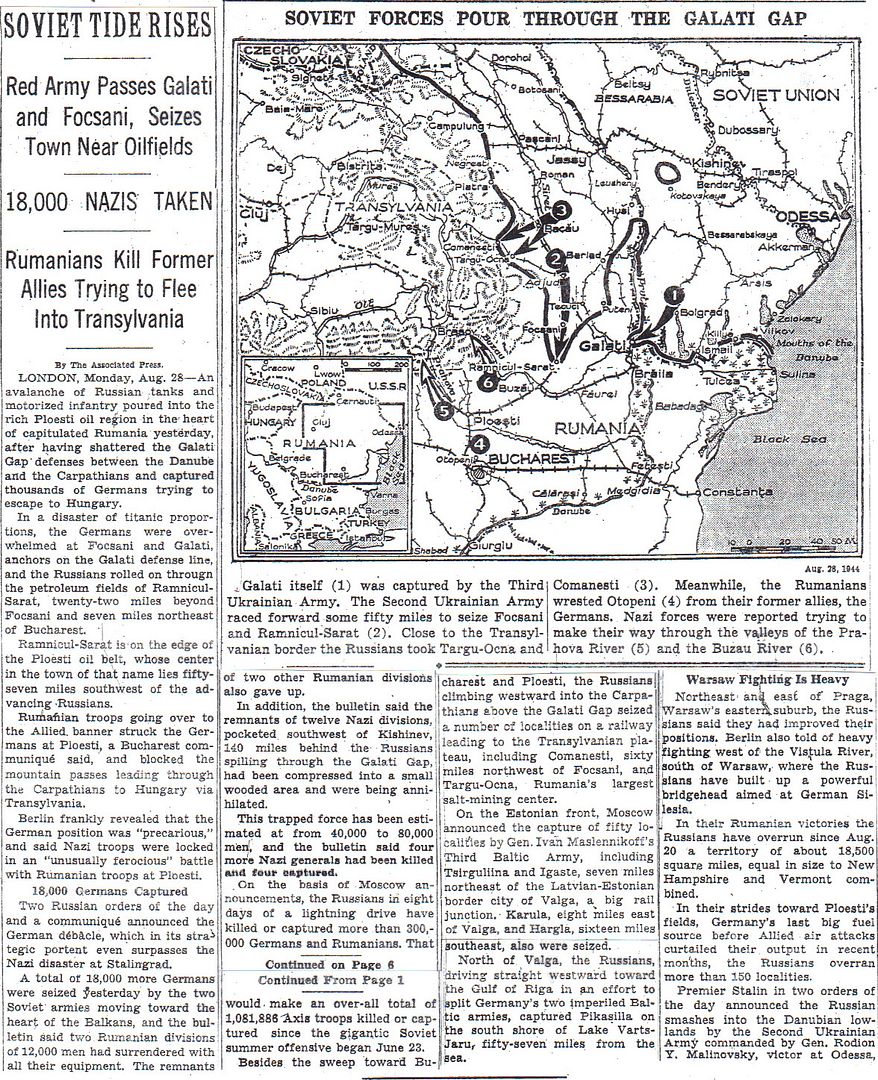
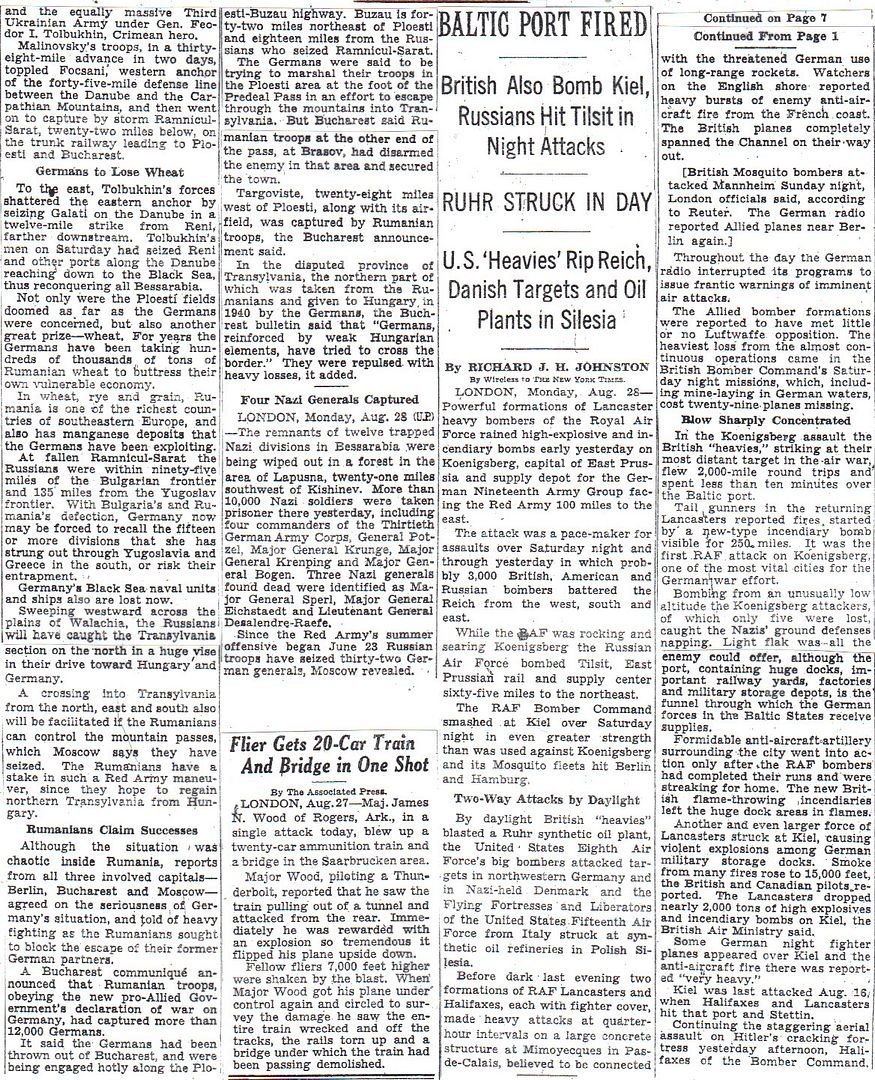

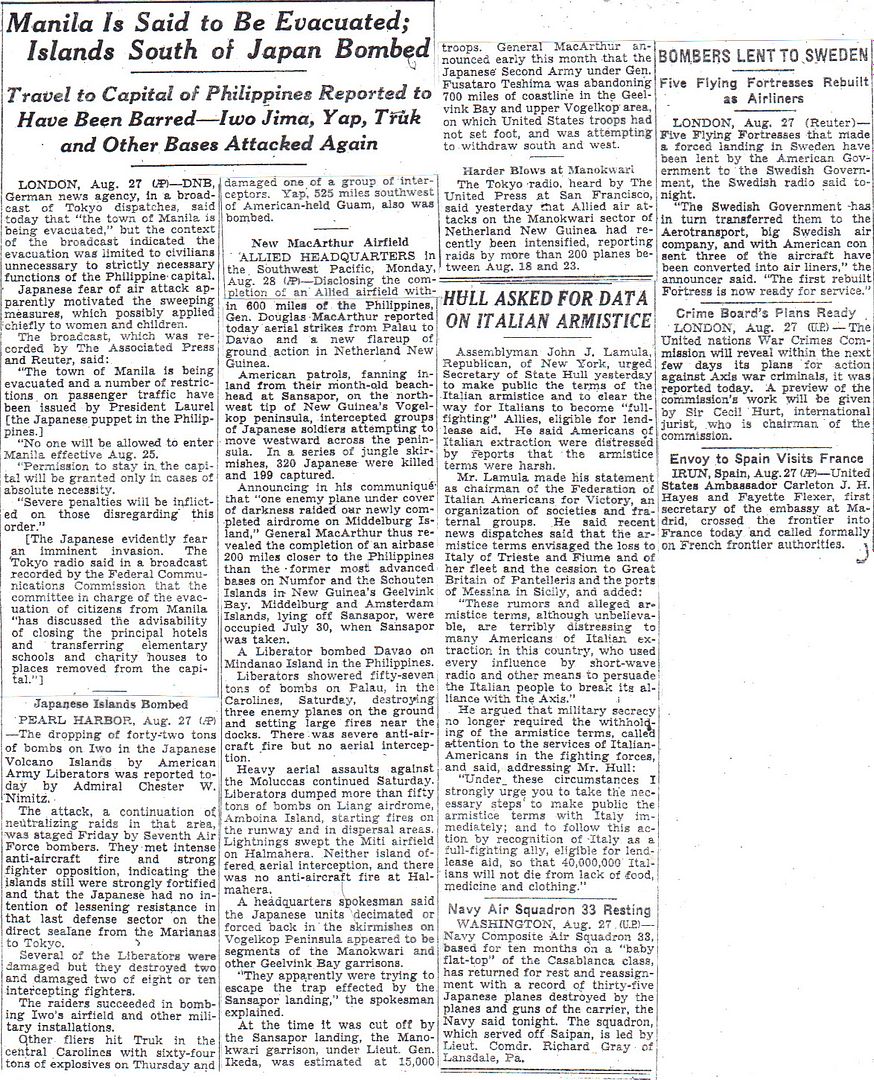
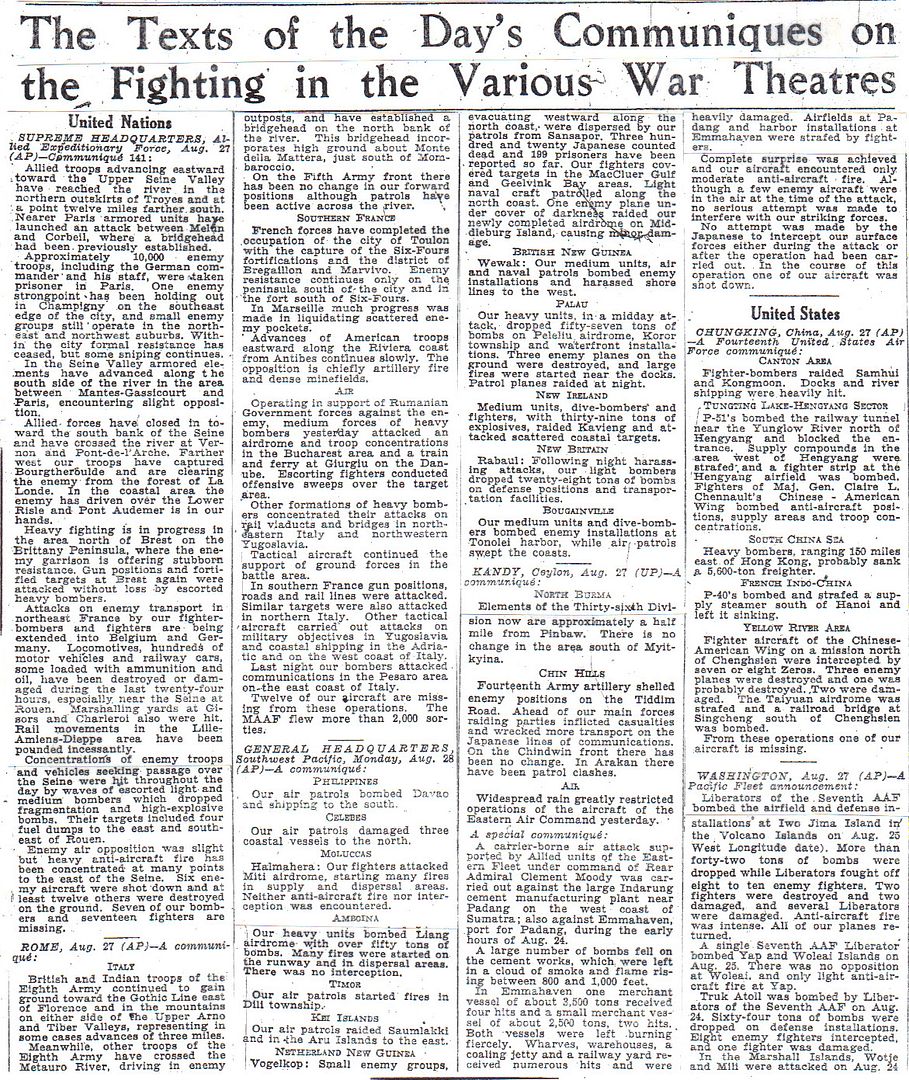
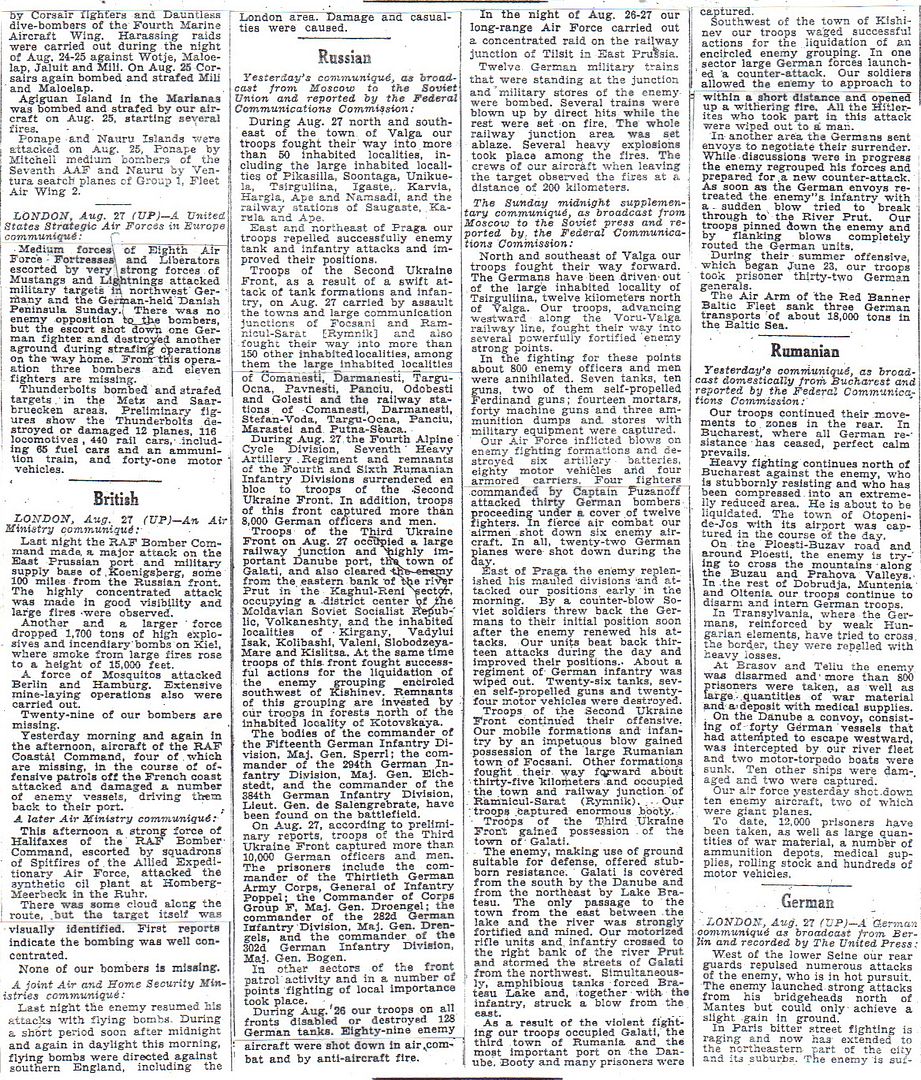
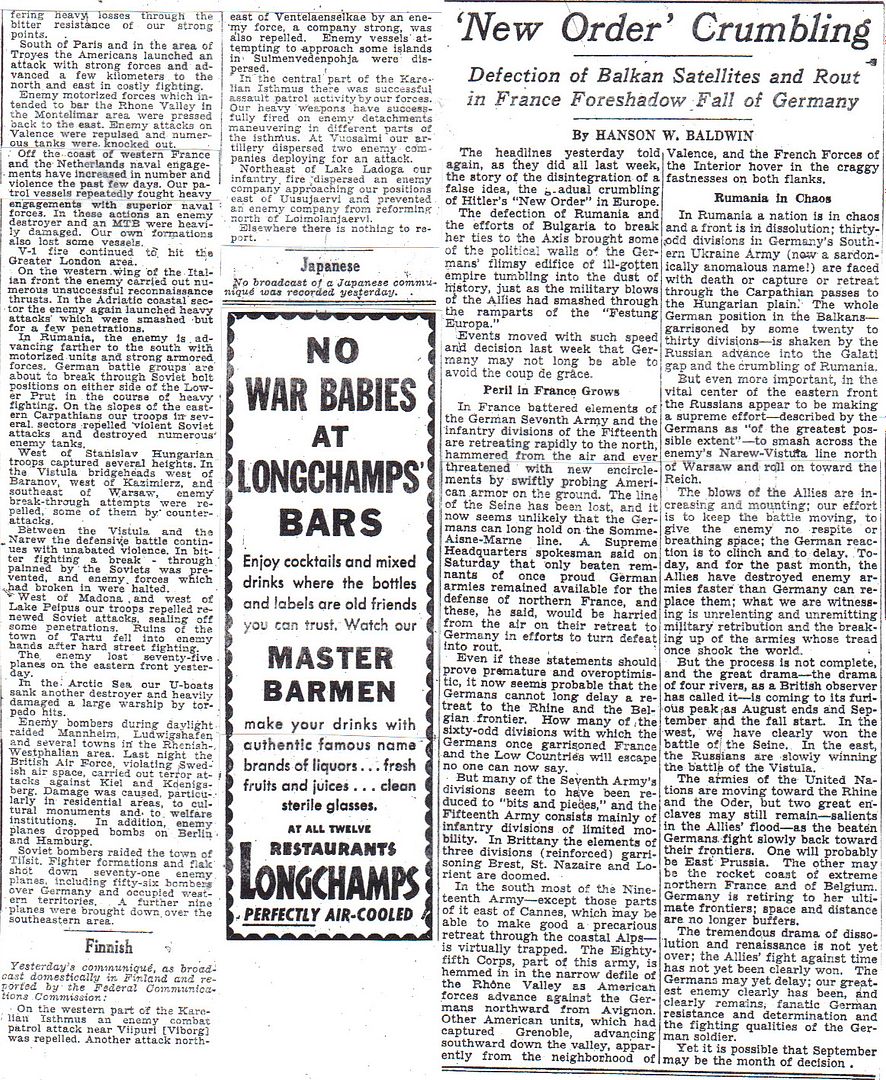
http://www.onwar.com/chrono/1944/aug44/28aug44.htm#
Americans cross the Marne
Monday, August 28, 1944 www.onwar.com
On the Western Front... Elements of US 1st Army cross the Marne River at Meaux. The US 3rd Army is approaching Reims. To the west of Paris, the British 21st Army Group continues to advance as well.
In Southern France... The German garrisons in Toulon and Marseilles surrender. In the Rhone valley, some elements of the German 19th Army have been cut off, to the south of Montelimar, by forces of the US 7th Army. Among those elements is the German 11th Panzer Division, which launches an attack northward and succeeds in breaking through the line with heavy losses from Allied artillery and ground attack aircraft.
On the Eastern Front... Elements of the Soviet 2nd Ukrainian Front swing west and move through the Oituz Pass over the Carpathian Mountains toward Transylvania. On the Danube, the 3rd Ukrainian Front captures Braila.
In Budapest... A new Hungarian government takes office, led by General Lakatos. They announce that they are prepared to negotiate with the Soviets.
In Washington... At Dumbarton Oaks, senior Allied representatives meet to discuss postwar security.
http://www.etherit.co.uk/month/thismonth/28.htm
August 28th, 1944 (MONDAY)
UNITED KINGDOM: Weather prevents US Eight Air Force heavy bomber operations from England; 835 fighters, in 3 forces, are dispatched on fighter-bomber and strafing attacks on rail targets in the Netherlands, Belgium, France and GERMANY: 20 fighters are lost.
(1) 174 P-38s, P-47 Thunderbolts and P-51 Mustangs attack transportation targets on the German/French border; they claim 12-1-0 aircraft in the air and 3-0-4 on the ground; 1 P-38 is lost.
(2) 143 P-38s and P-47s hit transportation targets in France, Belgium and the Netherlands; they claim 4-0-0 aircraft in the air and 3-0-2 on the ground; 3 P-47s are lost.
(3) An unknown number of 380 P-51s strafe transportation targets on the French/German border; they claim 3-0-0 aircraft in the air and 5-0-2 on the ground; 16 P-51s are lost.
Mission 588: 6 B-17s drop leaflets in France and the Netherlands during the night.
London: The V1 flying-bomb threat against England is being overcome. Of 94 V1s launched today, only four got through to London. The defence-in-depth tactics are now paying off. The missiles have first to face RAF fighter patrols overt the Channel - and then a belt of anti-aircraft guns on the south coast. Behind this are further hungry fighters. Finally, as they begin their descent, they have to contend with a balloon barrage on the southern outskirts of the capital. Meanwhile, in France, the Allied armies continue to overrun launching sites.
A USAAF Douglas (Model DC-4A) C-54A-1-DC, msn 10276, USAAF serial number 42-72171, crashes into a residential area at 0100 hours local in poor visibility while attempting to land at RAF Prestwick, Ayrshire, Scotland, after a trans-Atlantic flight. All 20 aboard the aircraft and five people on the ground are killed.
Aircraft carrier HMS Implacable commissioned.
FRANCE: U.S. Lieutenant General Leonard T. Gerow, Commanding General V Corps, in a letter to French General Pierre Joseph Koening, Military Governor of Paris, turns over the city to the French.
In northern France, the U.S. First Army crosses the Marne River at Meaux while the U.S. Third Army (Patton) rumbles 50 miles (80,5 kilometres) and closes in on Chalons-sur-Marne and Vitro-le-Francois. Patton’s tanks and trucks are only 140 miles (225,3 kilometres) from the French-German border but are running out of diesel fuel and gasoline. (John Nicholas and Jack McKillop)
Three men from U-262 were killed and 1 more wounded during an air raid on La Pallice. The boat left for its next patrol on 23 August for its traverse to Germany, reaching Flensburg on 5 November.
In southern France, French troops led by General Jean de Lattre de Tassigny eliminate German resistance in Marseilles and Toulon, France’s biggest Mediterranean ports, and the German forces surrender. Marseilles’s liberation is a godsend for the Allies, who badly need an undamaged French seaport. During the next three months, one-third of Allied supplies and equipment will be offloaded in Marseilles and forwarded to Eisenhower’s armies. The German 11th Panzer Division is cut off, south of Montelimar in the Rhone Valley. In attacking to the north they take severe losses from artillery and air strikes. (John Nicholas and Jack McKillop)
Marseilles: Last week General Schaeffer, the German commander in Marseilles, spurned a French proposal to surrender. Today he capitulated, as his counterpart in Toulon did yesterday; Free French forces under General de Lattre de Tassigny have captured the two great ports of southern France, and with their fall the entire French Mediterranean coast has now been liberated.
Marseilles surrendered after bloody, and often confused, fighting in which the regular French forces and the largely communist local Resistance fighters appeared at times to be waging a private war. Some 4,000 French casualties are feared, but German losses are heavier and about 37,000 prisoners have been taken. The port itself is a mass of twisted metal with 11 sunken ships blocking the main inlet.
The fight for Toulon, ringed by 30 forts, was no less fierce, often taking place in underground galleries built by the French but developed by the Germans. Today Admiral Ruhfuss, the German commander surrendered and agreed to hand over maps of his minefields.
The 11th Panzer Div. is cut off, south of Montelimar in the Rhone Valley. In attacking to the north they take severe losses from artillery and air strikes.
In northern FRANCE, the US Ninth Air Force dispatches B-26s and A-20 Havocs, escorted by fighters, to bomb fuel dumps at Doullens, Barisis-aux-Bois, an ammunition dump at Querrieu, an ammunition and fuel dump at Compiegne/Foret de Laigue, and an alcohol distillery and fuel storage depot at Hamm; fighters escort about 400 C-47 Skytrains on supply and evacuation runs, attack airfields at Bourges and Peronne, support ground forces, and fly armed reconnaissance from Amiens to east of Dijon.
In southeastern FRANCE and ITALY, US Twelfth Air Force B-25s bomb railroad bridges in the Lyon, France area. In Italy, B-26s destroy several airplanes at Villafranca di Verona Airfield and a bridge at Parma; A-20s hit motor transport and other targets of opportunity during the night of 27/28 August, fly armed reconnaissance over the Po Valley and blast a command post southeast of Genoa; fighter-bombers hit vehicles in the Rhone Valley of France, bomb and strafe roads and bridges in the battle area north of the Arno River and hit shipping in Imperia and Savona harbors.
GERMANY: U-3506 launched
U-2522, U-3014 and U-3516 laid down.
AUSTRIA: One hundred fifty five B-17 Flying Fortresses of the USAAF Fifteenth Air Force in Italy bomb the Moosbierbaum benzine refinery at Vienna without loss.
SWEDEN: British Overseas Airlines Corp. Lockheed 18-56 Lodestar (ex USAAF C-60A-5-LO, s/n 42-56018), msn 18-2491, registered G-AGIH, crashes at Kinnekulle; 4 of the 8 aboard the aircraft survive.
POLAND: Warsaw: The Poles, fighting with their customary gallantry, continue to hold out in battered, starving Warsaw against the Wehrmacht while Stalin refuses to help and the Red Army waits on the far side of the Vistula. The Luftwaffe has been brought in to bomb the Poles, and heavy artillery is shelling the city to pieces. So fierce is the bombardment that the Home Army has been forced to abandon its positions in the Old Town and has gone literally underground - into the sewers, from whence its members emerge to attack the Germans. They are hungry, but what they really want are guns.
A new government in HUNGARY takes office. Headed by General Lakatos, they announce their readiness to negotiate with the Russians.
B-24 Liberators of the USAAF Fifteenth Air Force in Italy attack three targets: 105 bomb the marshalling yard at Miskolc, 103 bomb the Szony Oil Refinery at Komarom, and 84 bomb the Szajol Railroad Bridge at Szolnok. Two aircraft are lost.
During the night of 28/29 August, six RAF Liberators of No. 205 (Heavy Bomber) Group mine the Danube River.
ROMANIA: The Third Ukraine Front takes Braila on the Danube. Units of the Second Ukraine Front drive into Transylvania through the Oituz Pass in the Carpathian Mountains.
During the night of 28/29 August, three RAF Liberators of No. 205 (Heavy Bomber) Group mine the Danube River.
YUGOSLAVIA: A B-24 LIberator of the USAAF Fifteenth Air Force in Italy bombs the marshalling yard at Subotica.
During the night of 28/29 August, nine RAF Liberators of No. 205 (Heavy Bomber) Group mine the Danube River.
EASTERN FRONT: The 3rd Ukraine Front takes Braila on the Danube. Units of the 2nd Ukraine Front move through the Carpathian Mountains toward Transylvania.
U.S.S.R.: Polar Fleet and White Sea Flotilla: HS “Nord” - by U-boat, close to Beluha Is. (Sergey Anisimov)(69)
ITALY: The British Eighth Army continues to gain ground toward the Gothic Line with the Polish 2 Corps reaching the Arzilla River. During the night of 28/29 August, elements of the 8th Indian Division capture Tigliano, north of Pontassieve.
USAAF Twelfth Air Force B-26 Marauders destroy several airplanes at Villafranca di Verona Airfield and a bridge at Parma; fighter-bombers bomb and strafe roads and bridges in the battle area north of the Arno River and hit shipping in Imperia and Savona harbors.
B-24 Liberators of the USAAF Fifteenth Air Force attack four targets: 59 bomb the railroad bridge at Ora, 40 bomb the railroad viaduct at Aviso, ten bomb the railroad bridge at Peschiera Del Grade and nine bomb the highway bridge at Zambana. Two aircraft are lost.
During the night of 28/29 August, 50 RAF Liberators of No. 205 (Heavy Bomber) Group bomb troop concentrations at Pesano.
The US Fifteenth Air Force in Italy sends 560+ bombers, escorted by P-38s and P-51s, to strike targets in Austria, Hungary and Italy; B-17s hit Moosbierbaum oil refinery and adjacent chemical works in Austria; B-24s hit an oil refinery at Szony and marshalling yards at Miskolc, Hungary; and railroad bridges and viaducts at Szolnok, Hungary; and Zambana, Avisio, and Ora Italy.
FRENCH MOROCCO: British Overseas Airways Corp C-47A-1-DK, msn 11932, registered G-AGIR, crashes at Telmest in the Atlas Mountains south-southwest of Casablanca.
US Seventh Air Force B-24s based on Saipan pound Iwo Jima Island by day and night while Marshall Islands-based B-24s hit Truk Atoll.
MARSHALL ISLANDS: The USN’s Task Force 38, with eight fleet carriers and eight light aircraft carriers, sorties from Eniwetok Atoll to attack Japanese bases in the western Pacific in support of the upcoming invasion of the Palau Islands. The aircraft carriers, and their assigned groups, of TF 38 are
- Task Group 38.1 (TG-38.1)
USS Belleau Wood (CVL-24) with Light Carrier Air Group Twenty One (CVLG-21)
USS Cowpens (CVL-25) with CVLG-22
USS Hornet (CV-12) with Carrier Air Group Two (CVG-2)
USS Monterey (CVL-26) with CVLG-28
USS Wasp (CV-18) with CVG-14
- TG 38.2
USS Bunker Hill (CV-17) with CVG-8
USS Cabot (CVL-28) with CVLG-31
USS Independence (CVL-22) with Night Light Carrier Air Group Forty Two [CVLG(N)-42]
USS Intrepid (CV-11) with CVG-18
- TG 38.3
USS Essex (CV-9) with CVG-15
USS Langley (CVL-27) with CVLG-32
USS Lexington (CV-16) with CVG-19)
USS Princeton (CVL-23) with CVLG-27
- TG 38.4
USS Enterprise (CV-6) with CVG-20
USS Franklin (CV-13) with CVG-13
USS San Jacinto (CVL-30) with CVLG-51
Palau Islands: US Far East Air Force B-24s hit the airfield on Koror Island, and the seaplane base on Arakabesan Island.
CANADA: Frigate HMCS St Pierre commissioned. A/S towing vessel HMCS Brentwood assigned to HMCS Cornwallis.
U.S.A.: Brigadier General Haywood S Hansell, Jr assumes command of the XXI Bomber Command, Twentieth Air Force, at Peterson Field, Colorado Springs, Colorado; Brigadier General Lauris Norstad succeeds Hansell as Chief of Staff of the Twentieth Air Force.
Submarine USS Blueback commissioned.
Destroyer escort USS Johnnie Hutchins commissioned.
Minesweeper USS Inflict commissioned.
Destroyer USS Hank commissioned.
ATLANTIC OCEAN: U-859 sank SS John Barry.
The USN’s Task Force 38, with 8 fleet carriers and 8 light aircraft carriers, sorties from Eniwetok Atoll to attack Japanese bases in the western Pacific in support of the upcoming invasion of the Palau Islands.
The aircraft carriers, and their assigned groups, of TF 38 are:
- Task Group 38.1 (TG-38.1)
USS Belleau Wood (CVL-24) with Light Carrier Air Group Twenty One
(CVLG-21)
USS Cowpens (CVL-25) with CVLG-22
USS Hornet (CV-12) with Carrier Air Group Two (CVG-2)
USS Monterey (CVL-26) with CVLG-28
USS Wasp (CV-18) with CVG-14
- TG 38.2
USS Bunker Hill (CV-17) with CVG-8
USS Cabot (CVL-28) with CVLG-31
USS Independence (CVL-22) with Night Light Carrier Air Group Forty Two
[CVLG(N)-42]
USS Intrepid (CV-11) with CVG-18
- TG 38.3
USS Essex (CV-9) with CVG-15
USS Langley (CVL-27) with CVLG-32
USS Lexington (CV-16) with CVG-19)
USS Princeton (CVL-23) with CVLG-27
- TG 38.4
USS Enterprise (CV-6) with CVG-20
USS Franklin (CV-13) with CVG-13
USS Jacinto (CVL-30) with CVLG-51
And Deux Metres just stood there like a wooden Indian, didn't even look around, they say. Even his enemies couldn't legitimately question his bravery, ever.
I wonder if it was based in religious fatalism. I'm inclined to think, "So I could die ... *shrug* ... whatever," myself.
 |
| IU Archives |
| U.S. troops enter Paris, 1944. |
Multimedia |
PARIS, August 28, 1944 – I had thought that for me there could never again be any elation in war. But I had reckoned without the liberation of Paris – I had reckoned without remembering that I might be a part of this richly historic day.
We are in Paris – on the first day – one of the great days of all time. This is being written, as other correspondents are writing their pieces, under an emotional tension, a pent-up semi-delirium.
Our approach to Paris was hectic. We had waited for three days in a nearby town while hourly our reports on what was going on in Paris changed and contradicted themselves. Of a morning it would look as though we were about to break through the German ring around Paris and come to the aid of the brave French Forces of the Interior who were holding parts of the city. By afternoon it would seem the enemy had reinforced until another Stalingrad was developing. We could not bear to think of the destruction of Paris, and yet at times it seemed desperately inevitable.
That was the situation this morning when we left Rambouillet and decided to feel our way timidly toward the very outskirts of Paris. And then, when we were within about eight miles, rumors began to circulate that the French 2nd Armored Division was in the city. We argued for half an hour at a crossroads with a French captain who was holding us up, and finally he freed us and waved us on.
For fifteen minutes we drove through a flat gardenlike country under a magnificent bright sun and amidst greenery, with distant banks of smoke pillaring the horizon ahead and to our left. And then we came gradually into the suburbs, and soon into Paris itself and a pandemonium of surely the greatest mass joy that has ever happened.
*
The streets were lined as by Fourth of July parade crowds at home, only this crowd was almost hysterical. The streets of Paris are very wide, and they were packed on each side. The women were all brightly dressed in white or red blouses and colorful peasant skirts, with flowers in their hair and big flashy earrings. Everybody was throwing flowers, and even serpentine.
As our jeep eased through the crowds, thousands of people crowded up, leaving only a narrow corridor, and frantic men, women and children grabbed us and kissed us and shook our hands and beat on our shoulders and slapped our backs and shouted their joy as we passed.
I was in a jeep with Henry Gorrell of the United Press, Capt. Carl Pergler of Washington, D.C., and Corp. Alexander Belon of Amherst, Massachusetts. We all got kissed until we were literally red in face, and I must say we enjoyed it.
Once when the jeep was simply swamped in human traffic and had to stop, we were swarmed over and hugged and kissed and torn at. Everybody, even beautiful girls, insisted on kissing you on both cheeks. Somehow I got started kissing babies that were held up by their parents, and for a while I looked like a baby-kissing politician going down the street. The fact that I hadn’t shaved for days, and was gray-bearded as well as bald-headed, made no difference. Once when we came to a stop, some Frenchman told us there were still snipers shooting, so we put our steel helmets back on.
The people certainly looked well fed and well dressed. The streets were lined with green trees and modern buildings. All the stores were closed in holiday. Bicycles were so thick I have an idea there have been plenty of accidents today, with tanks and jeeps overrunning the populace.
We entered Paris via Rue Aristide Briand and Rue d’Orléans. We were slightly apprehensive, but decided it was all right to keep going as long as there were crowds. But finally we were stymied by the people in the streets, and then above the din we heard some not-too-distant explosions – the Germans trying to destroy bridges across the Seine. And then the rattling of machine guns up the street, and that old battlefield whine of high-velocity shells just overhead. Some of us veterans ducked, but the Parisians just laughed and continued to carry on.
There came running over to our jeep a tall, thin, happy woman in a light brown dress, who spoke perfect American.
She was Mrs. Helen Cardon, who lived in Paris for twenty-one years and has not been home to America since 1935. Her husband is an officer in French Army headquarters and home now after two and a half years as a German prisoner. He was with her, in civilian clothes.
Mrs. Cardon has a sister, Mrs. George Swikart, of New York, and I can say here to her relatives in America that she is well and happy. Incidentally, her two children, Edgar and Peter, are the only two American children, she says, who have been in Paris throughout the entire war.
*
We entered Paris from due south and the Germans were still battling in the heart of the city along the Seine when we arrived, but they were doomed. There was a full French armored division in the city, plus American troops entering constantly.
The farthest we got in our first hour in Paris was near the Senate building, where some Germans were holed up and firing desperately. So we took a hotel room nearby and decided to write while the others fought. By the time you read this I’m sure Paris will once again be free for Frenchmen, and I’ll be out all over town getting my bald head kissed. Of all the days of national joy I’ve ever witnessed this is the biggest.

Reminds me of a scene near the end of the movie “Day of the Jackal” where he’s got his scope through a tiny window on the top of a large building trained on the back of de Gaulle's head . Just as she shoots, de Gaulle leans over to congratulate an honoree and the bullet hits the ground in front of de Gaulle. Pretty well-done scene - very realistic.
Thanks again for Ernie Pyle’s articles. He was a great journalist. It’s too bad the School of Journalism that houses his archives doesn’t turn out his kind any more.
Oh, tomorrow we have a big parade in Paris. I’ll have some photos.
Sharp memory!
Task Force 38 is a big fleet.
It’s going to get bigger.
Thanks. If law school doesn’t kill you it will sharpen your memory and thinking skills.
Makes me wish they had done some kind of a sequel (usually never as good as the previous) to Casablanca where somehow Rick and Ilsa meet again in Paris (maybe her husband was killed) with all this stuff going on in the background.
Law school:
The first year they scare you to death.
The second year they work you to death.
The third year they bore you to death.
Manhattan Project declassfied August 21. This may be new information of interest to certain readers.
http://blogs.archives.gov/transformingclassification/?p=702
No wonder people were thinking this might be over by the end of the year.
Apparently, you had “certain readers” in mind. ;-)
I’ll check it out.
Disclaimer: Opinions posted on Free Republic are those of the individual posters and do not necessarily represent the opinion of Free Republic or its management. All materials posted herein are protected by copyright law and the exemption for fair use of copyrighted works.